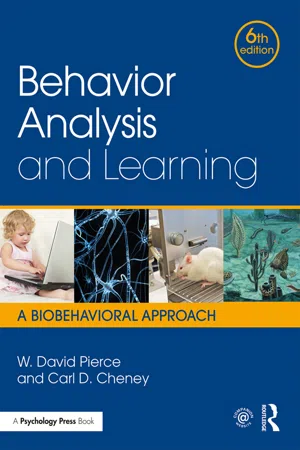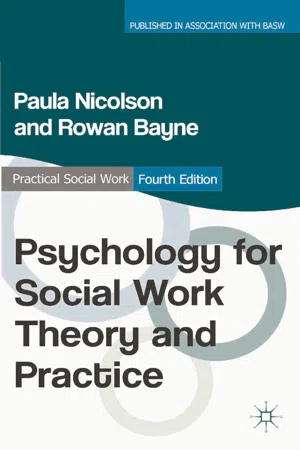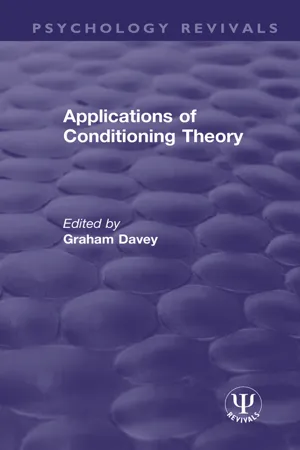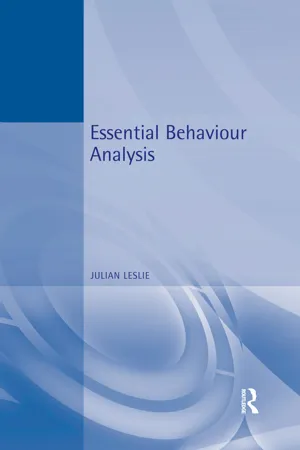Psychology
Operant Conditioning Applications
Operant conditioning applications involve using reinforcement and punishment to modify behavior. In real-world settings, this can be seen in various forms such as parenting techniques, classroom management strategies, and workplace behavior modification programs. By understanding and applying the principles of operant conditioning, individuals and organizations can effectively shape and influence behavior.
Written by Perlego with AI-assistance
Related key terms
5 Key excerpts on "Operant Conditioning Applications"
- eBook - ePub
Psychological Criminology
An Integrative Approach
- Richard Wortley(Author)
- 2023(Publication Date)
- Routledge(Publisher)
According to the operant conditioning model, behaviour is shaped by the consequences it produces. The consequences of behaviour can be rewarding (i.e., reinforcing) or unpleasant (i.e., punishing). Behaviour that is rewarded will be repeated while behaviour that is punished will be avoided. Skinner did not reject classical conditioning, but he regarded it as playing a relatively restricted role in learning. While classical conditioning explains behaviour as a reaction to the environment, operant conditioning explains behaviour as an action – or operation – upon the environment. While classical conditioning is concerned with what comes before behaviour, operant conditioning is largely concerned with what comes after behaviour. While classical conditioning is concerned with involuntary reflexes and physiological responses, operant conditioning is concerned with volitional behaviours. And while classical conditioning portrays organisms as passive receivers of learning, operant conditioning views organisms as active participants in learning. Principles of operant conditioning Skinner (1953) demonstrated the principles of operant conditioning in a series of experiments involving pigeons and rats. The general procedure for investigating the reinforcement of behaviour is as follows. A pigeon is placed in a box – sometimes referred to as Skinner box – which contains a disk that when pecked delivers food from a chute below. Left to its own devices and through accidentally pecking the disc from time to time, the pigeon eventually learns that each time the disc is pecked it will be rewarded with food. The behavioural response (R) produces a rewarding stimulus (S R). Next a red/green light is introduced into the Skinner box. Now the food is delivered only when the disc is pressed and the light is red. The red light signals the availability of the reward - eBook - ePub
Behavior Analysis and Learning
A Biobehavioral Approach, Sixth Edition
- W. David Pierce, Carl D. Cheney(Authors)
- 2017(Publication Date)
- Routledge(Publisher)
Reinforcement and Extinction of Operant Behavior 4- Learn about operant behavior and the basic contingencies of reinforcement.
- Discover whether reinforcement undermines intrinsic motivation.
- Learn how to carry out experiments on operant conditioning.
- Delve into reinforcement of variability, problem solving, and creativity.
- Investigate operant extinction and resistance to extinction.
A hungry lion returns to the waterhole where it has successfully ambushed prey. A person playing slot machines wins a jackpot and is more likely to play again than a person who does not win. Students who ask questions and are told “That’s an interesting point worth discussing” are prone to ask more questions. When a professor ignores questions or gives fuzzy answers, students eventually stop asking questions. In these examples (and many others), the consequences that follow behavior determine whether it will be repeated.Recall that operant behavior is said to be emitted (Chapter 2 ). When operant behavior is selected by reinforcing consequences, it increases in frequency. Behavior not followed by reinforcing consequences decreases in frequency. This process, called operant conditioning, is a major way that the behavior of organisms is changed on the basis of ontogeny or life experience (i.e., learning). It is important, however, to recognize that operant conditioning, as a process, has evolved over species history and is based on genetic endowment. Biologically, operant (and respondent) conditioning as a general behavior-change process is based on phylogeny or species history. In other words, those organisms, whose behavior changed on the basis of consequences encountered during their lifetimes, were more likely to survive and reproduce than animals that did not evolve such a capacity. Adaptation by operant learning is a mechanism of survival that furthers reproductive success.Operant Behavior
Operant behavior is sometimes described as intentional, free, voluntary, or willful. Examples of operant behavior include conversations with others, driving a car, taking notes, reading a book, and painting a picture. From a scientific perspective, operant behavior is determined and lawful and may be analyzed in terms of its relationship to environmental events. Formally, responses that produce a change in the environment and increase in frequency due to that change are called operants. The term operant comes from the verb to operate and refers to behavior that operates on the environment to produce effects or consequences, which in turn strengthen the behavior. The consequences of operant behavior are many and varied and occur across all sensory dimensions. When you turn on a light, dial a telephone number, drive a car, or open a door, these operants result in visual clarity, conversation, reaching a destination, or entering a room. A positive reinforcer - eBook - ePub
- Paula Nicolson, Rowan Bayne(Authors)
- 2014(Publication Date)
- Bloomsbury Academic(Publisher)
stimuli in order to make sense of the world. A child might learn that when her father has had too much to drink he hits her, and the pain makes her cry. Thus, when she hears her father returning from the pub she responds by bursting into tears before he has a chance to be violent. She has learnt that the combination of her father returning home and the place that he has been to indicate punishment for her. This is an example of classical conditioning.Operant conditioning, described by Skinner (1953), occurs when an individual learns that some behaviour of his/her own leads to a particular consequence. A boy may take part in a range of activities at home, but when he plays with guns, and behaves in a typically ‘masculine’ way, his mother smiles at him. He therefore learns to behave in this way more frequently, as it gains his mother’s approval. This process was studied by Skinner who demonstrated that behaviour in rats and pigeons can be conditioned if responses are followed by reinforcement, the reward or punishment following particular manifestations of behaviour. The mother smiling at the little boy’s games is the reinforcement. Conversely, a little girl playing with guns may have them taken from her, or be told with a frown that her behaviour is ‘unladylike’. This acts as a punishment, and the child learns not to behave in that particular way. Skinner, in direct contrast to Freud, challenged the idea of human agency, or self-determination, believing that human states of mind do not cause behaviour. For Skinner inner processes such as thinking and feeling are simply responses to the external world.Behaviour modification based on the theory of operant condition is a method of helping someone change undesirable and antisocial behaviour by offering rewards or punishments. For instance children with learning disabilities often respond favourably to being cuddled or given sweets, and if they wash themselves or go to the toilet at the right time, they can be rewarded in that way. They learn to modify and adapt their behaviour as a means of obtaining the reward. CBT represents a more sophisticated approach to behavioural and cognitive change and works through enabling the individual to unlearn patterns of depressive or negative thoughts. This is particularly useful for changing the way depressed people see their lives and the world around them and adopt a more optimistic or hopeful outlook. - eBook - ePub
- Graham Davey(Author)
- 2017(Publication Date)
- Routledge(Publisher)
The experimental methods of operant conditioning have developed from Skinner's pioneering investigations (1938). He defined operant behaviour as that which organisms emit and which is affected by its consequences, intending thereby to distinguish it from the more stereotyped and limited reflexes which are simply elicited by antecedent stimuli and which formed the basis of earlier experimental studies in classical, or Pavlovian, conditioning. Operant conditioning is the empirical study of how such emitted and potentially variable behaviour may nevertheless adjust to different arrangements of environmental circumstances and consequences. The prototypical experiment certainly requires little exposition here, so well-known has it become in psychology. In general, laboratory animals such as rats or pigeons are exposed to consistent arrangements of environmental events which are carefully controlled by the investigator. This can be achieved by testing the animals in constrained chambers (Skinner boxes) in which extraneous and uncontrolled environmental variations can be kept to a minimum, and in which the animals can remain for substantial periods of time without being disturbed by the experimenter. Within such environments, a limited number of readily controlled events can be introduced by the experimenters. These generally take the form of lights or noises (either of which may be sustained or relatively brief), the delivery of small amounts of food or water, and in some experiments the occasional delivery of brief electric shocks. Within these limited arrangements, the animal is free to behave in a variety of ways at any time. However, there is usually some device in the test chamber which can be readily operated by the animal, such as a key at which a pigeon may peck or a lever which a rat may press. If such patterns of behaviour occur, they can be easily recorded in a consistent and objective manner, usually by the automatic sensing of the closure of a microswitch or contact relay, though more sophisticated recording systems have also been used. Normally these patterns of behaviour, which are arbitrarily selected on the basis of their convenience to both the experimenter and the animal, provide the examples of operant behaviour whose occurrence is studied in the different conditions provided by different arrangements of lights, noises, food-presentations, etc. - eBook - ePub
- Julian Leslie(Author)
- 2015(Publication Date)
- Routledge(Publisher)
In the experiment described above, it is typically found that, while different participants start out by pressing the lever in various ways, as the experiment progresses, they show an increasing tendency to use an economical paw movement to press the lever. Third, the biology of the species influences what can be learnt. Thorndike was the first to realize that not all behaviours can be equally easily changed by certain effects or consequences. Seligman (1970) called this the preparedness of certain behaviours to be modified by certain consequences, and related this phenomenon to the evolutionary history of the species. 3.5 Outcomes of Operant Conditioning In summary, when operant conditioning is implemented in a simple laboratory situation such as a Skinner box, behaviour changes in four ways. The rate of the operant response increases relative to its operant or base level. The rate of the operant response increases relative to the rate of other responses occurring in the situation. The pattern or sequence of behaviour changes to a loop involving the operant response and this loop is repeated again and again. The form or topography of that response becomes stereotyped, while requiring a minimum effort and being influenced by the participant's preparedness to make the response for the consequence arranged for it. In simple laboratory experiments with a variety of species, lever pressing, string pulling and pole tilting represent convenient acts chosen by experimenters to study the effects of environmental consequences on behaviour. The suitability of these responses for studying operant conditioning depends critically upon their ability to be modified as described. Formally, responses or response classes are defined as operants if they can be increased in frequency and strengthened in the four stated ways by making certain consequences contingent upon them
Index pages curate the most relevant extracts from our library of academic textbooks. They’ve been created using an in-house natural language model (NLM), each adding context and meaning to key research topics.




